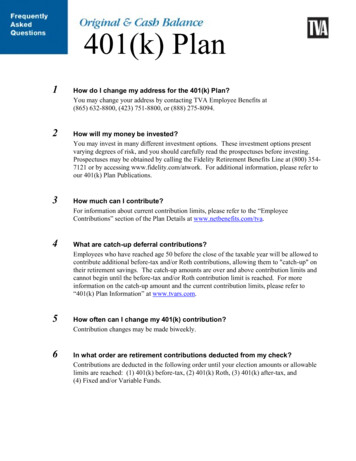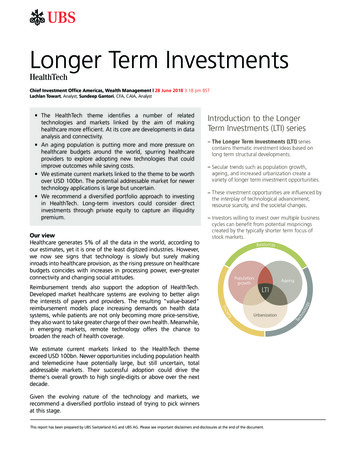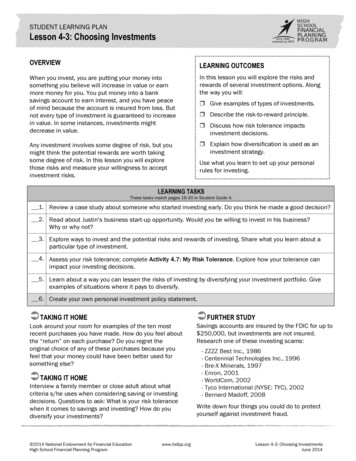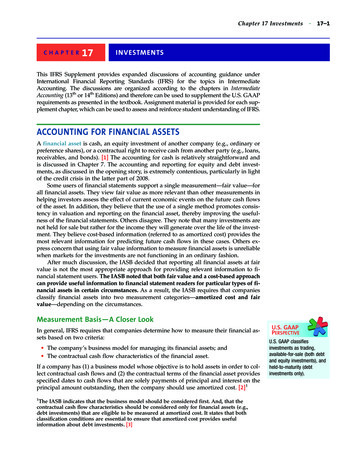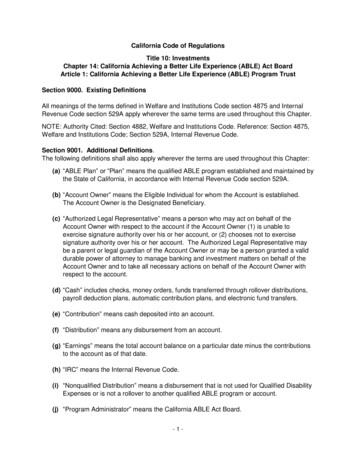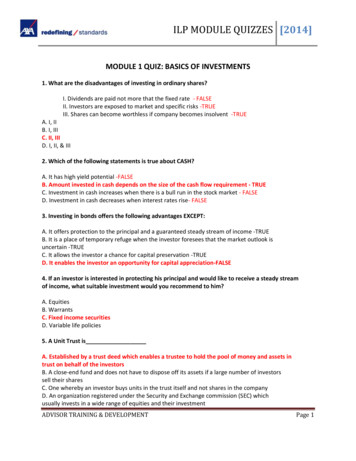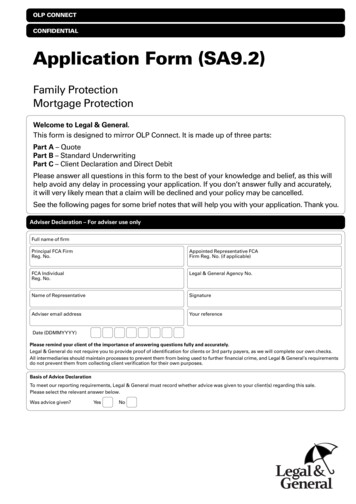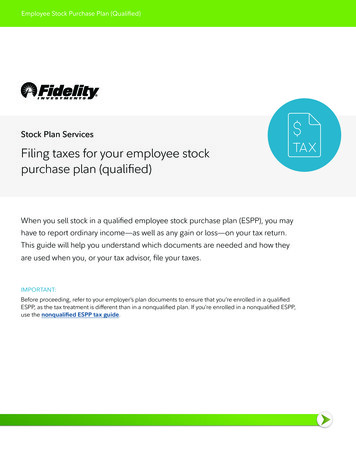
Transcription
Employee Stock Purchase Plan (Qualified)Stock Plan ServicesFiling taxes for your employee stockpurchase plan (qualified)When you sell stock in a qualified employee stock purchase plan (ESPP), you mayhave to report ordinary income—as well as any gain or loss—on your tax return.This guide will help you understand which documents are needed and how theyare used when you, or your tax advisor, file your taxes.IMPORTANT:Before proceeding, refer to your employer’s plan documents to ensure that you’re enrolled in a qualifiedESPP, as the tax treatment is different than in a nonqualified plan. If you’re enrolled in a nonqualified ESPP,use the nonqualified ESPP tax guide.
Employee Stock Purchase Plan (Qualified)Gather the following documentsIn order to accurately file your taxes, there are several documents and forms you may need. Some will beprovided by your employer and others will come from Fidelity or the IRS. Below is a list of potentially importantdocuments and how to get them. Make sure you have all of the applicable forms prior to filing your taxes.Log in to Fidelity.com/taxforms to see what forms you’ll receive and when you’ll get them.FormWhy it’s neededWhere to find itForm W-2Your W-2 shows the value of youraward and the taxes that havebeen withheld.This form is provided byyour employer.Form 1099-BThis IRS form has details about yourstock sale and helps you calculateany capital gain/loss.Available online atFidelity.com/taxforms and alsomailed to you. You can find outwhen you’ll receive them online.2020 Supplemental InformationThe Supplemental Information form,created by Fidelity, may contain information not reported on your 1099-Bdue to IRS regulations.IRS Form 8949These IRS forms are used to reporttaxes on equity award(s).Available online at www.irs.gov,*by calling 800.TAX.FORM(800.829.3676), or by visitingyour local IRS office.IRS Schedule D and Form 1040HOW THESE DOCUMENTS WORK TOGETHERForm8949Department of the TreasuryInternal Revenue ServiceSales and Other Dispositions of Capital Assets Go to www.irs.gov/Form8949 for instructions and the latest information.File with your Schedule D to list your transactions for lines 1b, 2, 3, 8b, 9, and 10 of Schedule D.Schedule DSCHEDULE DOMB No. 1545-0074Department of the TreasuryInternal Revenue Service (99)Social security number or taxpayer identification numberName(s) shown on returnCapital Gains and Losses(Form 1040)2020AttachmentSequence No. 12APart Itocomplete Short-Term. Transactions involving capital assets you held 1 year or less are generally short-term (seeinstructions). For long-term transactions, see page 2.Note: You may aggregate all short-term transactions reported on Form(s) 1099-B showing basis wasreported to the IRS and for which no adjustments or codes are required. Enter the totals directly onSchedule D, line 1a; you aren’t required to report these transactions on Form 8949 (see instructions).You must check Box A, B, or C below. Check only one box. If more than one box applies for your short-term transactions,complete a separate Form 8949, page 1, for each applicable box. If you have more short-term transactions than will fit on this pagefor one or more of the boxes, complete as many forms with the same box checked as you need.(A) Short-term transactions reported on Form(s) 1099-B showing basis was reported to the IRS (see Note above)(B) Short-term transactions reported on Form(s) 1099-B showing basis wasn’t reported to the IRS(C) Short-term transactions not reported to you on Form 1099-B1(a)Description of property(Example: 100 sh. XYZ Co.)(b)Date acquired(Mo., day, yr.)(c)Date sold ordisposed of(Mo., day, yr.)(d)Proceeds(sales price)(see instructions)Adjustment, if any, to gain or loss.If you enter an amount in column (g),(e)(h)enter a code in column (f).Cost or other basis.Gain or (loss).See the Note below See the separate instructions.Subtract column (e)and see Column (e)from column (d) and(f)(g)in the separatecombine the resultCode(s) frominstructionswith column (g)Amount ofinstructionsadjustment2020 Attach to Form 1040, 1040-SR, or 1040-NR.Go to www.irs.gov/ScheduleD for instructions and the latest information. Use Form 8949 to list your transactions for lines 1b, 2, 3, 8b, 9, and 10. Check onlyone box.Did you dispose of any investment(s) in a qualified opportunity fund during the tax year?YesNoIf “Yes,” attach Form 8949 and see its instructions for additional requirements for reporting your gain or loss.Part Iused for.Short-Term Capital Gains and Losses—Generally Assets Held One Year or Less (see instructions)See instructions for how to figure the amounts to enter on thelines below.This form may be easier to complete if you round off cents towhole dollars.(d)Proceeds(sales price)(e)Cost(or other basis)(g)Adjustmentsto gain or loss fromForm(s) 8949, Part I,line 2, column (g)Part II(d)Proceeds(sales price)(e)Cost(or other basis)used for.456()7(g)Adjustmentsto gain or loss fromForm(s) 8949, Part II,line 2, column (g)SupplementalInformation formCat. No. 37768ZFor Paperwork Reduction Act Notice, see your tax return instructions.Cat. No. 11338HIRS Use Only—Do not write or staple in this space.Head of household (HOH)Qualifying widow(er) (QW)Your social security numberSpouse’s social security numberApt. no.Foreign country namePresidential Election CampaignCheck here if you, or yourspouse if filing jointly, want 3to go to this fund. Checking abox below will not changeForeign postal code your tax or refund.StateZIP codeForeign province/state/countyAt any time during 2020, did you receive, sell, send, exchange, or otherwise acquire any financial interest in any virtual currency?StandardDeductionWere born before January 2, 1956Dependents (see instructions):(1) First nameIf morethan fourdependents,see instructionsand checkhere AttachSch. B ifrequired.YouSpouseYesNoSomeone can claim:You as a dependentYour spouse as a dependentSpouse itemizes on a separate return or you were a dual-status alienAge/Blindness You:1(2) Social securitynumberWages, salaries, tips, etc. Attach Form(s) W-22a3a4a5a6a78910aTax-exempt interest .Qualified dividends .IRA distributions . .Spouse:Are blindLast name.2a3a4a.Was born before January 2, 1956.b Taxable interest.b Ordinary dividends .b Taxable amount . .Pensions and annuities . .5ab Taxable amount .Social security benefits . .6ab Taxable amount .Capital gain or (loss). Attach Schedule D if required. If not required, check here. .12b3b4b5b6b7. 89. .10aCharitable contributions if you take the standard deduction. See instructions10bAdd lines 10a and 10b. These are your total adjustments to income . . . . 10c111213Subtract line 10c from line 9. This is your adjusted gross income . .Standard deduction or itemized deductions (from Schedule A). .Qualified business income deduction. Attach Form 8995 or Form 8995-A. .1112131415Add lines 12 and 13 . . . . . . . . . . . . . . . .Taxable income. Subtract line 14 from line 11. If zero or less, enter -0- .1415bcOther income from Schedule 1, line 9 . . . . . . . . .Add lines 1, 2b, 3b, 4b, 5b, 6b, 7, and 8. This is your total incomeAdjustments to income:From Schedule 1, line 22 . . . . . . . . . . . .Is blind(4) if qualifies for (see instructions):Child tax creditCredit for other dependents(3) Relationshipto you.For Disclosure, Privacy Act, and Paperwork Reduction Act Notice, see separate instructions.11 Gain from Form 4797, Part I; long-term gain from Forms 2439 and 6252; and long-term gain or (loss)from Forms 4684, 6781, and 8824 . . . . . . . . . . . . . . . . . . . . . . .12 Net long-term gain or (loss) from partnerships, S corporations, estates, and trusts from Schedule(s) K-113 Capital gain distributions. See the instructions . . . . . . . . . . . . . . . . . . .14 Long-term capital loss carryover. Enter the amount, if any, from line 13 of your Capital Loss CarryoverWorksheet in the instructions. . . . . . . . . . . . . . . . . . . . . . . .15 Net long-term capital gain or (loss). Combine lines 8a through 14 in column (h). Then, go to Part IIIon the back . . . . . . . . . . . . . . . . . . . . . . . . . . . . . . .Note: If you checked Box A above but the basis reported to the IRS was incorrect, enter in column (e) the basis as reported to the IRS, and enter anadjustment in column (g) to correct the basis. See Column (g) in the separate instructions for how to figure the amount of the adjustment.For Paperwork Reduction Act Notice, see your tax return instructions.OMB No. 1545-0074Married filing separately (MFS)Last name Single orMarried filingseparately, 12,400 Married filingjointly orQualifyingwidow(er), 24,800 Head ofhousehold, 18,650 If you checkedany box underStandardDeduction,see instructions.8b Totals for all transactions reported on Form(s) 8949 withBox D checked . . . . . . . . . . . . .9 Totals for all transactions reported on Form(s) 8949 withBox E checked . . . . . . . . . . . . .10 Totals for all transactions reported on Form(s) 8949 withBox F checked . . . . . . . . . . . . . .negative amounts). Enter each total here and include on yourSchedule D, line 1b (if Box A above is checked), line 2 (if Box Babove is checked), or line 3 (if Box C above is checked) Married filing jointlyLast nameStandardDeduction for—(h) Gain or (loss)Subtract column (e)from column (d) andcombine the resultwith column (g)8a Totals for all long-term transactions reported on Form1099-B for which basis was reported to the IRS and forwhich you have no adjustments (see instructions).However, if you choose to report all these transactionson Form 8949, leave this line blank and go to line 8b .2 Totals. Add the amounts in columns (d), (e), (g), and (h) (subtractSingleIf joint return, spouse’s first name and middle initialCity, town, or post office. If you have a foreign address, also complete spaces below.Long-Term Capital Gains and Losses—Generally Assets Held More Than One Year (see instructions)See instructions for how to figure the amounts to enter on thelines below.This form may be easier to complete if you round off cents towhole dollars.(99)Department of the Treasury—Internal Revenue ServiceIf you checked the MFS box, enter the name of your spouse. If you checked the HOH or QW box, enter the child’s name if the qualifyingperson is a child but not your dependent Your first name and middle initialHome address (number and street). If you have a P.O. box, see instructions.(h) Gain or (loss)Subtract column (e)from column (d) andcombine the resultwith column (g)1a Totals for all short-term transactions reported on Form1099-B for which basis was reported to the IRS and forwhich you have no adjustments (see instructions).However, if you choose to report all these transactionson Form 8949, leave this line blank and go to line 1b .1b Totals for all transactions reported on Form(s) 8949 withBox A checked . . . . . . . . . . . . .2 Totals for all transactions reported on Form(s) 8949 withBox B checked . . . . . . . . . . . . .3 Totals for all transactions reported on Form(s) 8949 withBox C checked . . . . . . . . . . . . .4 Short-term gain from Form 6252 and short-term gain or (loss) from Forms 4684, 6781, and 8824 . .5 Net short-term gain or (loss) from partnerships, S corporations, estates, and trusts fromSchedule(s) K-1 . . . . . . . . . . . . . . . . . . . . . . . . . . . . .6 Short-term capital loss carryover. Enter the amount, if any, from line 8 of your Capital Loss CarryoverWorksheet in the instructions. . . . . . . . . . . . . . . . . . . . . . . .7 Net short-term capital gain or (loss). Combine lines 1a through 6 in column (h). If you have any longterm capital gains or losses, go to Part II below. Otherwise, go to Part III on the back . . . . . .1040 U.S. Individual Income Tax Return 2020Filing StatusAttachmentSequence No. 12Your social security numberName(s) shown on returnBefore you check Box A, B, or C below, see whether you received any Form(s) 1099-B or substitute statement(s) from your broker. A substitutestatement will have the same information as Form 1099-B. Either will show whether your basis (usually your cost) was reported to the IRS by yourbroker and may even tell you which box to check.Form 1040OMB No. 1545-0074FormForm 8949Form 1099-B.Cat. No. 11320BForm1040 (2020)11121314 ()15Schedule D (Form 1040) 2020Form 8949 (2020)* Fidelity is not involved in the preparation of the content supplied at the third-party unaffiliated website and does not guarantee or assume anyresponsibility for its content.2
Employee Stock Purchase Plan (Qualified)What to do when you’ve sold stockNow that you have sold shares that you purchased through your company’s qualified ESPP, there are two key piecesof information you should be aware of: Your ESPP is taxed when you sell shares. You have taxable ordinary income to report as well as any capital gain/loss from the sale.As you file your taxes, you’ll want to consider if you made a qualified or disqualified disposition. Income tax andcapital gains are taxed differently, based on how long you’ve held the shares.In order to receive beneficial tax treatment given under Section 423 for your ESPP, you are required to hold the shares: More than one year from the purchase date and More than two years from the offering date.QUALIFIED DISPOSITIONDISQUALIFIED DISPOSITIONIf shares are sold after the requiredholding periods, it is considered aqualified disposition and is eligiblefor the Section 423 beneficialtax treatment.If shares are sold before the requiredholding periods, it is considered adisqualified disposition and noteligible for the Section 423beneficial tax treatment.Still not sure which disposition applies to your sale? Learn more about qualified and disqualified dispositions.3
Employee Stock Purchase Plan (Qualified) How your ESPP information is reported on your W-2When you sell ESPP shares, your employer reports your ESPP income as wages in box 1 of your Form W-2. ESPPshave no withholding for income tax, and Social Security and Medicare taxes do not apply. Whether you had aqualified or disqualified disposition determines how much of the income is on your W-2. The tax amounts,along with the value of your shares, may be reported on your W-2. The information on your W-2 is used to fill outtax form 1040.Even if your employer doesn’t report the income from an ESPP on your W-2, you’re still responsible for reportingand paying ordinary income tax.HOW IS AN AWARD REFLECTED ON A W-2?Example: IRS W-2 for an Employee Stock Purchase Plan (Qualified)*ABOX 1 AESPP income will usuallybe included with your othercompensation in box 1.BOX 14 BBCYour employer may alsouse box 14 to report thecompensation alreadyincluded in box 1.BOXES 16 &18 CESPP income could be included in boxes16 and 18, if state and local taxes apply.For illustrative purposes only.* Fidelity is not involved in the preparation of the content supplied at the third-party unaffiliated website and does not guarantee or assume anyresponsibility for its content.4
Employee Stock Purchase Plan (Qualified)Understanding ESPP gain or loss from a saleWhen you sell shares of stock, you need to report any gain or loss from the sale.Accurately reporting your gain or loss will help keep you from overpaying taxes.A capital gain/loss is the difference between your sale price and your cost basis. If you sell stock for more than you paid for it, you recognize a gain. If you sell it for less than you paid for it, it’s considered a loss. How much of that gain or loss you report depends on your cost basis.Your capital gain/loss and cost basis information are located on the 1099-B andSupplemental Information form. Often the cost basis on your 1099-B andSupplemental Information form will differ. In this instance you’ll want to reviewthe adjusted cost basis on your Supplemental Information form to help preventoverpaying taxes. The details from these forms are used to calculate your capitalgain or loss on IRS Forms 8949, 1040, and Schedule D.IMPORTANTMake sure you have both your1099-B and SupplementalInformation form whenreporting your gain or loss.The information on your1099-B is reported to theIRS, but the SupplementalInformation form includesadjustments necessary toavoid overpaying taxes. You’llwant to use the informationon the SupplementalInformation form to makeany necessary adjustmentson Form 8949. To learn moreabout how your gain/loss iscalculated, see how cost basisfactors into the equation.5
Employee Stock Purchase Plan (Qualified)Using Form 1099-B and the Supplemental Information formIf you sold stock, you’ll receive Form 1099-B and the Supplemental Information form during the tax season.The information on your 1099-B is reported to the IRS, but the Supplemental Information form includesadjustments to a capital gain or loss necessary to avoid overpaying taxes. It’s important that you review andutilize the Supplemental Information form, as it is not reported to the IRS. Below are sample forms, alongwith key pieces of information you’ll find.HOW IS A SALE REFLECTED ON FORM 1099-B?Sample Form 1099-BSHORT-TERMOR LONG-TERMTRANSACTION AAThis is where you’ll seeif you had a short-term orlong-term transaction. Itwill help determine whichversion of Schedule D andForm 8949 you need.BCCOST OR OTHER BASIS BGAIN/LOSS C This is provided to the IRS and may Capital gain or loss from the sale of If the amounts on the 1099-B and If the amounts on the 1099-B andneed to be adjusted when you reportthe sale on Form 8949. If adjusted,you’ll find that value on theSupplemental Information form.Supplemental Information formdiffer, be sure to follow the steps toadjust the basis on Form 8949. Thiswill help you avoid overpaying taxes.shares. This amount may also needto be adjusted. In that case, you’llfind that value on the SupplementalInformation form.Supplemental Information formdiffer, be sure to use the adjustedamount on your SupplementalInformation form. This will help youavoid overpaying taxes.For illustrative purposes only.6
Employee Stock Purchase Plan (Qualified)Using Form 1099-B and the Supplemental Information form. continuedHOW IS A SALE REFLECTED ON THE SUPPLEMENTAL INFORMATION FORM?Sample Supplemental Information FormSHORT-TERMOR LONG-TERMTRANSACTION A This is where you’ll seeif you had a short-term orlong-term transaction. Itwill help determine whichversion of Schedule D andForm 8949 you need.ABCD Qualified dispositionswill always be consideredlong-term.ORDINARY INCOMEREPORTED BADJUSTEDCOST BASIS CADJUSTEDGAIN/LOSS D This amount (cross- This amount is used to This amount isreference it with yourW-2) is entered incolumn (g) of Form8949 to adjustthe basis.recalculate your gain/loss. It’s equal to theordinary income plusthe cost basison your 1099-B.recalculated per youradjusted cost basis. Itshows your proceedsminus your adjustedcost basis. Thisinformation is notreported to the IRS.You’ll want to use thisinformation whenreporting your taxes toavoid paying more intaxes than necessary.For illustrative purposes only.7
Employee Stock Purchase Plan (Qualified)Submitting the information to the IRSNow that you’ve gathered the information necessary to file your taxes,how do you submit it to the IRS?There are many ways to file your taxes: self-filing, using a tax-filing service, or with a tax advisor. Many tax-filingservices and programs allow you to automatically transfer information from Fidelity. Please note, however, that thisis not the case with the Supplemental Information form, and you’ll need to manually enter it.When filing the information you gathered will be used to report your taxes using IRS forms that include Form1040 (for the compensation income) and Schedule D and Form 8949 (for the stock sale). If you need assistancewith these forms, more information can be found in the links below.HOW DO I FILL OUT FORM 8949?HOW DO I FILL OUT SCHEDULE D? General IRS instructions Gener
Employee Stock Purchase Plan (Qualified) When you sell stock in a qualified employee stock purchase plan (ESPP), you may have to report ordinary income—as well as any gain or loss—on your tax return. This guide will help you understand which documents are needed and how they are used when you, or your tax advisor, file your taxes. IMPORTANT:File Size: 1MB
